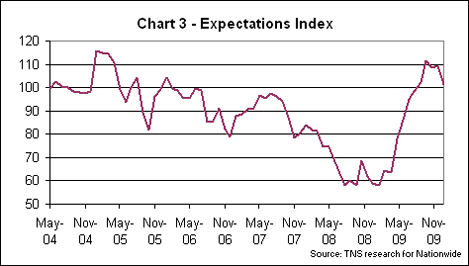Consumer expectations refer to the economic outlook of households. Expectations will have a significant bearing on current economic activity. If people expect an improvement in the economic outlook, they will be more willing to borrow and buy goods. But, with negative expectations, they will cut back on spending and be more risk-averse.
Expectations may also influence the impact of a government decision. For example, if the government cut taxes and finance it by borrowing more, at least some consumers, might expect the tax cut to prove temporary and in the future, taxes will rise to pay off the government debt. Therefore, the consumers will not spend the tax cut.
UK Consumer Expectations

At the start of 2009, consumer expectations were at a record low. An index of 60 implies more people are negative about future economic expectations. With such a negative outlook for the economy, a tax rise would have led to a big fall in consumer spending.
In that period, interest rates were cut to 0%, but even these interest rates cuts did little to improve spending – because many consumers were pessimistic about the future so they were saving any increase in disposable income. Therefore interest rate cuts were largely ineffective.
However, if you increased taxes when consumer expectations were very positive, the impact of a tax rise may have less impact. If consumers are confident about the future, they may reduce their saving rates and borrow more rather than reduce their spending.
Many ask why the government can increase the money supply and not create inflation. In usual circumstances, an increase in the money supply of £20 bn would be inflationary. But, these are not usual circumstances, banks are unwilling to lend, consumers are not keen to borrow. Therefore, the increased money supply is not increasing inflationary pressure at the present time. In other circumstances, they would
Summary
Economics is never straightforward. The impact of a policy can be very different in different circumstances. We always need to take into account other variables such as consumer expectations.
When teaching A-level economics, we often need to look for evaluation of a question. In macroeconomics one of the most effective strategies is to consider the impact of consumer confidence and expectations.
For example, suppose you have a question about the impact of a rise in VAT to 17.5%. The simple analysis is to say that the higher rate of tax will reduce consumer disposable income leading to a fall in consumer spending and economic growth.
However, the impact of a tax rise does depend on other factors.
Related
Note: Consumer Confidence index is compiled from 5 questions about current and future state of the economy. The consumer expectations just ask about the outlook for 6 months ahead. This shows people are expecting the economy to be better in 6 months.
